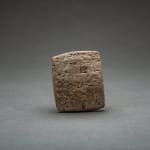Sumerian Cuneiform Terracotta Tablet, 2033 BCE
Terracotta
4 x 4.8 cm
1 5/8 x 1 7/8 in
1 5/8 x 1 7/8 in
LSO.111
Further images
Sumerian cuneiform is one of the earliest known forms of written expression. First appearing in the 4th millennium BC in what is now Iraq, it was dubbed cuneiform (‘wedge-shaped’) because...
Sumerian cuneiform is one of the earliest known forms of written expression. First appearing in the 4th millennium BC in what is now Iraq, it was dubbed cuneiform (‘wedge-shaped’) because of the distinctive wedge form of the letters, created by pressing a reed stylus into wet clay. Early Sumerian writings were essentially pictograms, which became simplified in the early and mid 3rd millennium BC to a series of strokes, along with a commensurate reduction in the number of discrete signs used (from c.1500 to 600). The script system had a very long life, and was used by the Sumerians as well as numerous later groups – notably the Assyrians, Elamites, Akkadians and Hittites – for around three thousand years. Certain signs and phonetic standards live on in modern languages of the Middle and Far East, but the writing system is essentially extinct. It was therefore cause for great excitement when the ‘code’ of ancient cuneiform was cracked by a group of English, French and German Assyriologists and philologists in the mid 19th century AD. This opened up a vital source of information about these ancient groups that could not have been obtained in any other way. Cuneiform was used on monuments dedicated to heroic – and usually royal – individuals, but perhaps it’s most important function was that of record keeping. The palace-based society at Ur and other large urban centres was accompanied by a remarkably complex and multifaceted bureaucracy, which was run by professional administrators and a priestly class, all of whom were answerable to central court control. Most of what we know about the way the culture was run and administered comes from cuneiform tablets, which record the everyday running of the temple and palace complexes in minute detail, as in the present case. The Barakat Gallery has secured the services of Professor Lambert (University of Birmingham), a renowned expert in decipherment and translation of cuneiform, to examine and interpret the information on these tablets. His analysis is presented below: Clay tablet, 48 x 40 mm, with a total of 13 lines of Sumerian cuneiform on obverse and reverse, the surface rolled with the scribe’s cylinder seal. An administrative document from the period of the third dynasty of Ur, dated to the 5th year of the reign of Shu-Sin, fourth king of the dynasty, c. 2033 BC. Translation:
150 sila of ordinary bee 90 sila of barley flou 5 sila of coarse flou 5 sila of … flou The chief …, when he went to the … of the governor’s shepher Second time around, from Mr. Namma Document of Ur-duk Month: Duk Year: after Shu-Sin, king of Ur, built the west wal The year-name refers to a wall – like Hadrian’s Wall in England, and the Great Wall of China – built to keep out the migrating Amorites who were at this time coming down the Euphrates Valley from Syria (in the end it completely failed). A sila was a measure of capacity, about .85 of a litre. The document is from the state bureaucracy, worded only for use by the officials who ran the system.
150 sila of ordinary bee 90 sila of barley flou 5 sila of coarse flou 5 sila of … flou The chief …, when he went to the … of the governor’s shepher Second time around, from Mr. Namma Document of Ur-duk Month: Duk Year: after Shu-Sin, king of Ur, built the west wal The year-name refers to a wall – like Hadrian’s Wall in England, and the Great Wall of China – built to keep out the migrating Amorites who were at this time coming down the Euphrates Valley from Syria (in the end it completely failed). A sila was a measure of capacity, about .85 of a litre. The document is from the state bureaucracy, worded only for use by the officials who ran the system.







